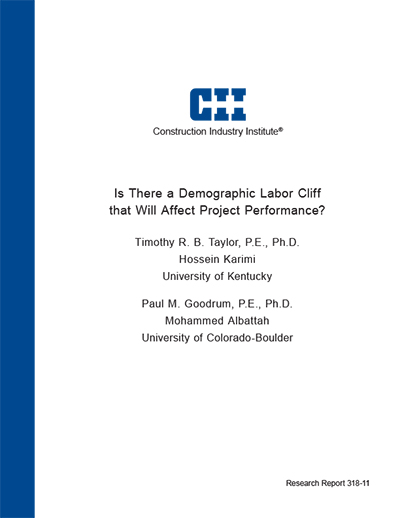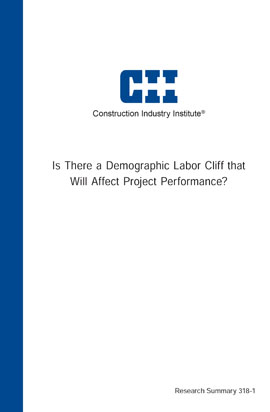
Is There a Demographic Labor Cliff that Will Affect Project Performance?
A shortage of skilled, qualified craft professionals has been an unfortunate recurring trend in the US and Canadian construction industry for the past three decades. A question that inspired the activities of CII Research Team 318 (RT-318) was if the labor shortage (aka labor cliff) is getting worse to the point that it is affecting project performance. Unfortunately, the answer is yes.
At the strategic level, RT-318 followed two parallel paths to investigate the labor shortage. Following a literature review, the first track sought to identify the critical trades and geographic locations of the craft shortages based on an extensive analysis of secondary data sources. The second track constructed a database of completed projects using data from an RT-318 survey and the CII Benchmarking and Metrics Database. Statistical regression analysis was used to develop the Craft Risk Availability Forecasting Tool (CRAFT) which quantifies the risk posed by labor availability on project safety, cost, and schedule performance. These parallel research paths derived the following conclusions and recommendations:
- The demographic craft labor cliff is here, and it is impacting project performance.
- The cliff varies by trade and region. The Southwest and Southeastern United States are currently experiencing skilled craft shortages, particularly among welders, pipefitters, and electricians.
- There are significant declines in real wages and widespread use of per diem to attract the needed craft. Construction craft workers feel less pride in their work are increasingly focused on higher wages at a time that the wage gap between construction craft labor at all other industries has shrunk.
- The average age of the U.S. construction craft workforce is increasing four times faster than all other U.S. industries during the last decade.
- Lack of educational attainment among the Hispanic workforce serves as a barrier to Hispanics moving into higher skilled trades where there is great demand such as welding, pipefitting, and electricians.
- Decline in career and technical education among high schools across the country and the emphasis on four-year degrees as a path to career success.
Perhaps the most dramatic discoveries of RT-318 were made through the analyses of project data that examined the level of craft shortage being experienced on projects along with key metrics related to safety, cost, and schedule. Through empirical project-based evidence, those analyses found that workforce shortages are directly correlated with at least three key elements of project execution:
- Safety – A labor shortage could cause OHSA TRIR rates on projects ranging from 0.26 to 0.94, depending on the severity of the shortage
- Cost – The presence of a labor shortage could cause projects to realize cost escalation over 17 percent depending on the severity of the shortage
- Schedule – The presence of a labor shortage could cause projects to experience schedule delays over 22 percent depending on the severity of the shortage
The skilled labor market for the construction industry has a serious structural problem, and the longer industry leaders erroneously assume that the market will take care of itself, the more severe the problem will become. The research report outlines a series of recommendations for the industry to begin reversing the trend of craft shortages and the impacts they are having on project performance. However, the solutions are complex and will require significant time and effort. All industry stakeholders must contribute to the solution. As the ultimate buyers of construction services, owners must demand robust workforce development efforts to level the playing field for labor providers. Labor providers must invest in developing a skilled workforce pipeline to ensure a sufficient numbers of workers when and where they are needed. By diligently planning for their workforce needs earlier in the project planning process, all stakeholders can muster greater capacity to influence their projects’ labor components and more effectively manage labor risk.



